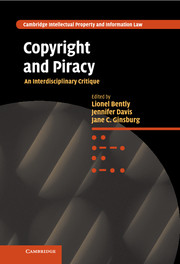Book contents
- Frontmatter
- Contents
- Notes on the contributors
- Editors' preface
- Table of cases
- Table of statutes
- Part I Introduction
- Part II History
- Part III Comparative Law
- Part IV Economics
- Part V Linguistics
- Part VI Computer software
- Part VII Information studies
- Part VIII Literature
- Part IX Art
- 16 Piracy and authorship in contemporary art and the artistic commonwealth
- 17 Copyright's imperfect republic and the artistic commonwealth
- Part X Sociology/music
- Part XI Criminology
- Bibliography
- Index
17 - Copyright's imperfect republic and the artistic commonwealth
from Part IX - Art
Published online by Cambridge University Press: 17 November 2010
- Frontmatter
- Contents
- Notes on the contributors
- Editors' preface
- Table of cases
- Table of statutes
- Part I Introduction
- Part II History
- Part III Comparative Law
- Part IV Economics
- Part V Linguistics
- Part VI Computer software
- Part VII Information studies
- Part VIII Literature
- Part IX Art
- 16 Piracy and authorship in contemporary art and the artistic commonwealth
- 17 Copyright's imperfect republic and the artistic commonwealth
- Part X Sociology/music
- Part XI Criminology
- Bibliography
- Index
Summary
Daniel McClean's contribution to this volume (Chapter 16) considers the norms of authorship and infringement in the culture of ‘high’ art. He suggests that this culture – even in its postmodern variants – is shaped by a predominant concern with the unique artefact and, as a result, obeys norms that differ significantly from those underpinning copyright law. He explains that, as a result of the fundamental discrepancies between these two systems, artists have been obliged to employ mechanisms outside copyright law to secure their interests and that copyright infringement proceedings involving ‘high’ artists sometimes fail to protect the conventions of the ‘artistic commonwealth’. He concludes by suggesting ways in which this gulf may be bridged. The chapter is a valuable addition to the literature on the relationship between art and copyright law, particularly because, while other scholars have explored issues relating to the subsistence and infringement of copyright in contemporary art in great detail, McClean reveals a fundamental conflict of preoccupation between the two cultures affecting all aspects of their relationship.
He claims that the institution of authorship in ‘high’ art culture is concerned with the ‘authorisation’ of unique artefacts. Such ‘authorisation’ confirms the existence of a physical link between artwork and creator. Surprisingly, this concern is as much a feature of postmodern artistic practice as of earlier movements in art:
A persistent feature of the art system would seem to be that no matter how authorship is critiqued by artists and how the artwork is dispersed through multiplication, reproduction and dematerialisation, the fetish for the auratic art object remains.
- Type
- Chapter
- Information
- Copyright and PiracyAn Interdisciplinary Critique, pp. 340 - 354Publisher: Cambridge University PressPrint publication year: 2010



